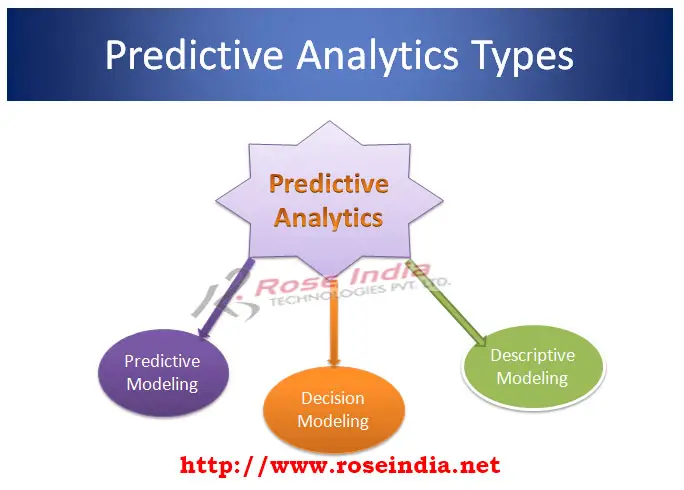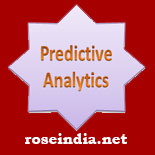What are the types of Predictive Analytics / Predictive Modeling?
Predictive Analytics is all about discovering hidden trends inside large collection of data. Today, we will discuss about 3 different types of predictive analytics being used in the industry to do large scale highly accurate predictive analytics.
The term predictive analytics is also called predictive modeling and it is being used interchangeably in the industry. Here the predictive models are developed by training algorithms with historical data and then use for prediction on new/historical data. The predictive analytics are getting increasingly popular due to its power of generating accurate predictions by analyzing volumes of data.
Predictive Analytics or Predictive modeling is of following types:
1. Predictive Modeling
2. Descriptive Modeling and
3. Decision Modeling
These three different types of predictive modeling is used in the industry to solve problems in different ways. One predictive analytics project may use one or more types of predictive analytics to achieve the project goals.

1. Predictive Modeling
The Predictive Modeling is used to analyze the performance of a specific unit in the data based on the one or more other values in the data set. For example bank can use to find the creditworthiness of a customer based on certain criterion identified by their manager. This helps banks to decide on whether to give loan/credit card to that customer. Predictive model can be developed to forecast stock price based on the current inputs. There are wide use of predictive modeling in the industry.
The predictive model can be used to discover patterns in data and generate the prediction, trends, probability from new data input data. It can be used in the marketing to answer questions about customer performance and other information which can be used by marketing team.
The predictive modeling can also be used in real-time transactions, for example if a customer is on the shopping website and places an order, then model can be used to detect other opportunity with that customer based the customer historical data. In banking industry it can be used in fraud detection in real-time and then take precautionary measures.
2. Descriptive Modeling
The descriptive modeling is used to understand the vast collection of data and quantify the relationships in the data. For example it can be used to classify the customer or entity in data into groups for further analysis. The descriptive mode is used to classify the data based on various features hidden inside the data. The descriptive modeling is used for the analysis of past data (historical data) for understanding trends. This technique is used to evaluate metrics over time. This is the easiest technique of data analysis because it requires very less coding and many tools are available to ease the development.
Various tools like Tableau, QlikView, KISSMetrics, Google Analytics, Microsoft Power BI etc... can be used to analyze data with minimal effort. These tools also provide various ready-make algorithms for data analysis and come with the powerful visualization engine.
The common example of descriptive modeling/analytics is the cash flow analysis in a company, the sales and review analysis of firm, various performance analyses. These days companies are using descriptive analysis to understand their data and get a view of data in dashboard format.
Various analytical tools help in analyzing and visualizing the data efficiently. The descriptive analytical tools can be used in combination with the Big Data for fast and timely analysis of data. So, data experts must learn various Big Data technologies to maximize the benefits of predictive analytics.
The main use of descriptive modeling is to cluster the customers according to demographics or other parameters. In the retail industry customers are clustered into various groups and then this information is used for various marketing purposes.
The descriptive modeling is used mostly for the following purposes:
Customer segmentation: This is one of important functionality in predictive modeling where customers are grouped into various groups. After grouping the customers correctly into various group marketing team can pitch to offer tailored services to these customers.
Value-based segmentation: The descriptive modeling is used to identify and quantify the customer based on various types of customer value. The value based segmentation has been used in the industry to pitch customer with tailored marketing plan.
Behavior-based segmentation: This can be used to analyze customer based on product usage and purchasing patterns.
Needs-based segmentation: This technique is used by companies to identify the customers having unique set of unmet needs. Such type of data can boost companies by offering right products to the right group of customers.
3. Decision Modeling/Decision Analytics
The decision modeling is used to describe relationship between all elements of a decision and present the combined outcome based on the all decision. This is the computer way of analyzing the outcome/prediction if certain numbers of decisions are taken by decision makers. For example if business owner decides on a set of business decision, then computer will present the expected/predicted result based on the current decisions. So, decision modeling is very important in the predictive analytics. Companies can use the predictive modeling techniques to help the decision makers in taking correct decision on time.
Top decision makers have to consider all the business parameters hidden in vast collection of data and then decide next course of action for their business. Some decisions must be taken very fast and in those scenarios decision modeling plays major role in helping decision makers.
Conclusion
The predictive analytics is highly used data science technology to uncover hidden information inside vast collection of data. The predictive analytics techniques are helping decision makers in predictive business outcome by analyzing historical and current data. Many tools are available for ready-made analytics of data and presenting data in nice dashboard format. For specific business need new models can be trained and deployed to get desired results by analyzing data sets.
In this section we have seen different types of predictive modeling and their specific use in the industry. We have large collection of Predictive Analytics and Data tutorials on our website. You can check all by visiting the section: Predictive Analytics and Data tutorials.
